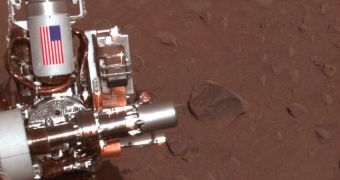Aluminum cuffs on both Mars Exploration Rovers (MER) are made of metal recycled from the World Trade Center buildings, engineers at Honeybee Robotics reveal. They say that they did this in order to honor the memory of the thousands of victims of the 9/11 attacks.
As part of both Spirit and Opportunity, these small amounts of aluminum now perform a new task, helping NASA and the rest of the world understand the nature of our solar system, as well as the ancient history of our neighboring planet.
The components serve as cable shields on each of the rock abrasion tools found on the two rovers' robotic arms. While contact with Spirit was lost forever, Opportunity has recently achieved an impressive milestone by reaching Endeavour Crater.
The rover has been driving for this landscape feature for three years, and now its rock abrasion tool is scanning the rock called Tisdale 2. Spirit lasted for nearly 7 years on Mars, while Opportunity is 5 months away from its 8th anniversary.
Honeybee Robotics engineers included the WTC materials because they were working on the rock abrasion tools in lower Manhattan when the attacks occurred on the World Trade Center complex.
Due to their tight schedule, they were unable to assist the rescue and relief efforts in any considerable manner, but they did the next best thing, honoring the memory of thousands of innocent victims with memorials on another planet.
The metal they obtained from Ground Zero was fashioned into cylinders bearing the American flag, as observable in the image to the left. In order to get their hands on the aluminum, the scientists needed to collaborate with a host of other institutions.
This effort involved the New York Mayor's Office, the NASA Jet Propulsion Laboratory (JPL), in Pasadena, California, a Round Rock, Texas-based metal-working shop and the lead investigator for the MER mission, Cornell University professor Steve Squyers.
“It's gratifying knowing that a piece of the World Trade Center is up there on Mars. That shield on Mars, to me, contrasts the destructive nature of the attackers with the ingenuity and hopeful attitude of Americans,” Honeybee founder and chairman Stephen Gorevan explains.
Long after both rovers will fall silent, the materials they carry will endure on the surface of Mars. Given the atmospheric conditions on the Red Planet, the components honoring the victims of the 2001 attacks will endure for millions of years, as a testament to our resilience.

 14 DAY TRIAL //
14 DAY TRIAL //